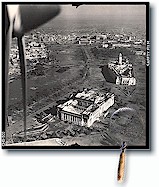

Despite the loss of Intramuros, the Japanese still held three strong positions, the Legislative, Finance and Agriculture Buildings, which lay just southeast of the old fortress. Since Rear Adm. Iwabuchi had expected U.S. attacks to come from the south, he had fortified these buildings more thoroughly than the more northerly strongpoints. It is probably also for this reason that Iwabuchi had put his headquarters in the Agriculture Building. The Legislative, Finance and Agriculture Buildings were of reinforced concrete. Window-sited machine guns covered exterior approaches. Sandbags and barricades blocked all ground-level doors and windows. Interiors were also fortified as in other strongpoints.
The U.S. artillery preparation on the buildings began on 25 February. However, the 1st Cavalry Division, then deployed along the bay shore west of Intramuros, reported shells falling on its positions. These were 37th Infantry Division rounds that had overshot the government buildings to fall on the 1st Cavalry Division. Major General Robert S. Beightler, commander of the 37th Infantry Division, immediately ordered a ceasefire at 1050 to resolve this problem by shifting troops out of the fire zone. Fires resumed at 1245. [xl]
On 26 February, the148th Infantry Regiment assaulted the Legislative Building and secured it by 28 February. The regimentís troops were harassed by Japanese firing up through holes in the floor and had to withdraw after their first assault to allow more shelling of the still vigorously resisting defenders. On 26 February, the 5th Cavalry Regiment assaulted the Agriculture Building after an artillery preparation, but troops had to withdraw because of withering Japanese covering fire from the nearby San Luis Terrace Apartments. The 5th Cavalry Regiment had to spend 27 February clearing out the apartments. On 28 February, the regiment returned to the Agriculture Building with a three-hour artillery preparation. Point-blank 155mm howitzer fires alternated with point-blank tank and tank-destroyer fires, with all of these fires aimed no higher than the first floor of the Agriculture Building so as to avoid endangering friendly troops. Much of the Agriculture Building thus pancaked on its own first floor, and the 5th Cavalry Regiment assaulted into what was left. A flamethrower tank reduced a pillbox on the southeast corner, and other tanks swarmed around the building to provide point-blank 75mm fire. The 5th Cavalry Regiment otherwise used flamethrowers, bazookas and small arms.
Dr. Thomas M. Huber